Ten Precariously Situated Cliffside Constructions from the Ancient World
By: Ancient Origins
Over the centuries, ancient people all over the world have built incredible structures on the sides of cliff faces. Some had a desire to be closer to the heavens and were searching for a sacred location, others sought a defensive outlook and protection from enemies, and still more found these locations to be ideal sites for the eternal resting of their deceased. The impressive structures used to achieve these goals include precariously hanging monasteries, giant statues, cliff-side tombs, and even entire villages that have been carved into cliffs.
1. The Precariously Hanging Monastery of Mount Heng
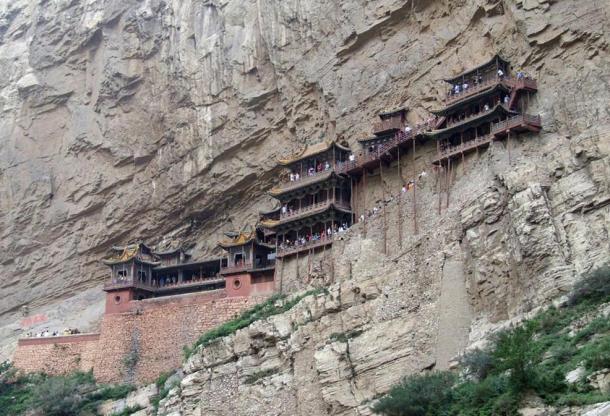
Hengshan, or Mount Heng, which is located in Shanxi province, is one of China’s Five Great Mountains. Pinned to the side of its cliff face is the Xuan Kong Si, also known as the Hanging Monastery. The monastery is dedicated to three religious systems – Buddhism, Taoism, and Confucianism, all of which co-exist harmoniously in the building and served to enable almost all travelers to rest there.
The Hanging Monastery was built in 491 AD, during the late Northern Wei Dynasty. It is commonly believed that the building of the monastery was initiated by a single individual, a monk by the name of Liao Ran, who later received help from Taoist builders. The site was perfect for those engaged in meditation, as noises from the ground did not reach such lofty heights. In addition, its height ensured that the monastery was safe from floods. The Hanging Monastery is also protected from rain, snow and sun as it is sheltered by the mountain’s peak. This is one of the reasons for the monastery’s continual existence over the centuries.
In order to provide support for the monastery, holes were first drilled into the side of the cliff. Wooden pillars were then half inserted into the rock as the foundation. The monastery was then built on top of these pillars, with additional support from the rock at the back of the building. It was subsequently enlarged over the centuries, and was also restored in 1900 during the Qing Dynasty.
2. The Thousand-Year History of the Spectacular Cliff Face Monastery of Sumela
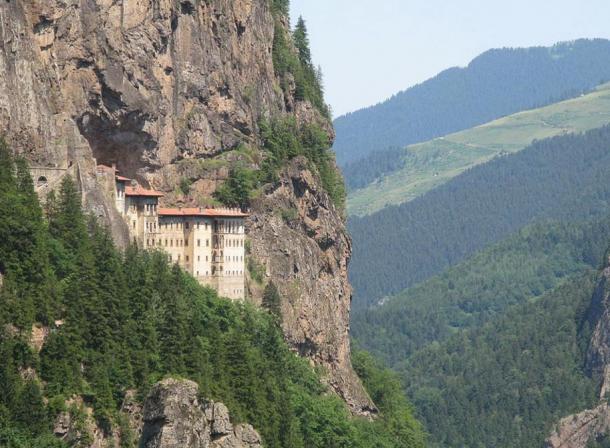
The Sumela Monastery is one of the oldest and most historic monasteries in the Christian world. There are no exact records about when it was built or by who, but it is estimated that its history dates back some one thousand years and that the locals who constructed it did so to escape enemy attacks. This incredible feat of architecture is located high up on the steep cliffs above the surrounding forest in Trabzon, Turkey. Over the centuries, Sumela thrived and became an important location not only for monks, but for pilgrims. It changed hands many times over the course of its existence, until it was finally abandoned in 1923.
The structure appears almost glued to the mountainside and has an entrance that is reached by climbing a long and narrow stairway where there is a large aqueduct at the top with many arches, which has mostly been restored. The main buildings of the Monastery complex are its Rock Church (which is covered both inside and out with biblical frescoes), chapels, kitchens, student rooms, a guesthouse, library and a fountain used to collect spring water from the mountain, which was revered by the Greeks.
One popular legend says that two monks from Athens, St Barnabas and his nephew St. Sophronios, saw an image of the virgin in a cave (now the Rock Church) and decided to build the monastery on that spot in 386 AD. However, many historians maintain that the monastery was in existence long before this.
3. Paro Taktsang: The Breathtaking Himalayan Cloud Monastery
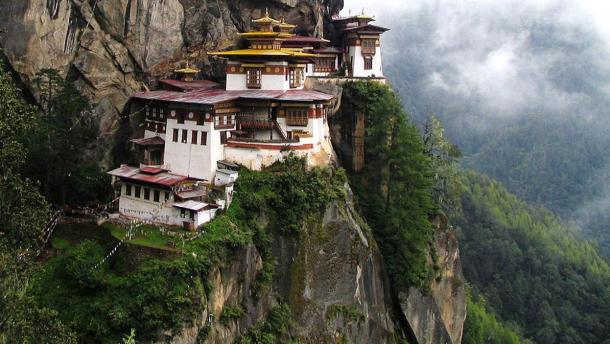
Paro Taktsang is located in the Himalayan mountains in Bhutan. It is one of the most revered places of pilgrimage, with a founding shrouded in strange tales and legend. Built in the late 17th century, it withstood the test of time until several years ago when it was nearly destroyed by fire. Today, it is considered to be one of the holiest sites in Bhutan as well as a cultural icon that is open only once a year in a special ceremony. The monastery also has an ancient history of occupation by monks, and monks who arrive here often stay for at least for three years, seldom leaving it.
The name “Taktsang" literally means Tiger's Lair and was derived when the people in the locality came across a tigress residing in one of the caves. The building of Paro Taktsang Monastery began in 1692, by Gyalse Tenzin Rabgye, Bhutan’s leader at the time. He is believed to have been the reincarnation of Rinpoche (a Brahmin royal who spread Tantric Buddhism throughout Bhutan and Tibet in the 700s) and founded the monastery by planting its first stone during a visit to the holy caves. Legend says that when the temple was built, it was anchored to the cliff by the hairs of female celestial beings known as khandroma.
The Paro Taktsang monastery has four main temples and residential shelters. Each building has a balcony, which provides views of the Paro valley below. The buildings are interconnected through rock stairways and steps along with several wooden bridges. There are eight caves, four of which are fairly easy to access. The entrance to the main cave is through a narrow passage. It holds twelve images of Bodhisattvas with butter lamps burning in front of these idols. Paintings can also be found on the walls of the monastery along with a sacred scripture which is kept in an adjoining small cell.
4. The Cliff Dwellings of Mesa Verde
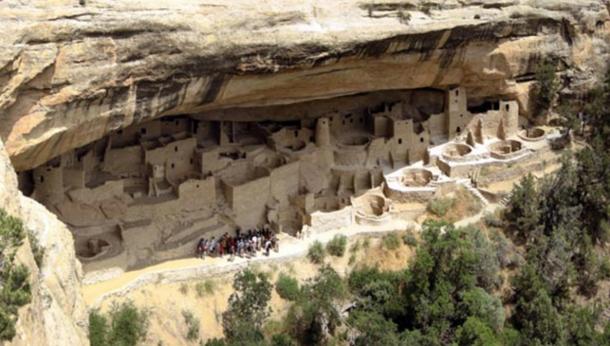
Mesa Verde is a green sanctuary for the soul. Located in southwestern Colorado near the Four Corners region, this massive geological uplift was once home to many Ancestral Puebloans. Mesa Verde is Spanish for “green table,” and the area covered with juniper and piñon trees indeed provided refuge from the harsher and drier landscape of the high desert below.
Some of North America’s most spectacular cliff dwellings are found here, including Cliff Palace and Spruce Tree House. Occupied between 600 and 1300 AD, the mesa is cut by numerous canyons running generally north and south. These canyons are pocketed with giant rock alcoves under which the ancient people built large villages of sandstone. Cliff Palace was inhabited between about 1190 and 1300. It contains some 220 rooms and 23 circular kivas (subterranean, ceremonial prayer-chambers)—the largest cliff dwelling in the American Southwest. This pueblo, a sort of ancient stone apartment complex, also included a round tower and a four-story square tower from which the sacred “sun watchers” made their celestial observations.
5. Kizil Caves, earliest Buddhist caves in China, hide rare images from the time of the Silk Route
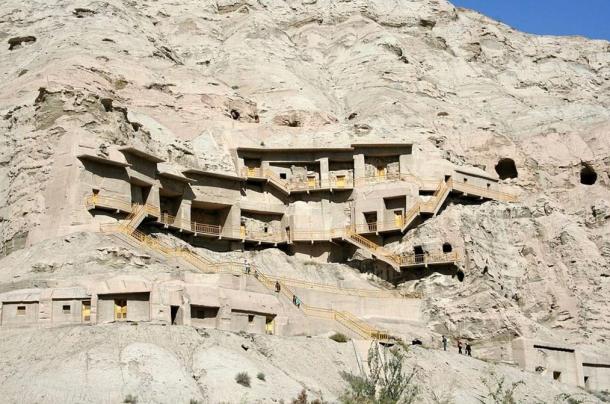
The Kizil Cave complex is believed to be the earliest major Buddhist cave complex in China, and is located in Baicheng County, Xinjiang. The development of this cave complex is said to have occurred between the 3rd and 8th centuries AD. There are 236 known cave temples carved into the cliff from east to west, spanning a length of 2 kilometers (1.2 miles). Of these, around 135 are still relatively intact.
Like other Buddhist rock-cut cave complexes, the caves at Kizil may be divided into two major categories: monastic cells which were simple and unadorned, and halls of worship which were often sumptuously decorated with murals and sculptures. These murals include sacred themes such as karma, as well as secular images of daily life such as farming, hunting, and playing music. Most of the murals are lacking in Chinese influence. As a matter of fact, only two of the caves at Kizil display Tang Chinese elements. By contrast, there is a greater presence of Graeco-Indian (Gandharan) and Sassanian (Iranian) elements. The occurrence of these Western artistic styles may not be as surprising as it may seem, considering that Western travellers along the Silk Route would have passed through Xinjiang on their journey to China.
6. The Leshan Giant Buddha: Largest Stone Buddha in the World
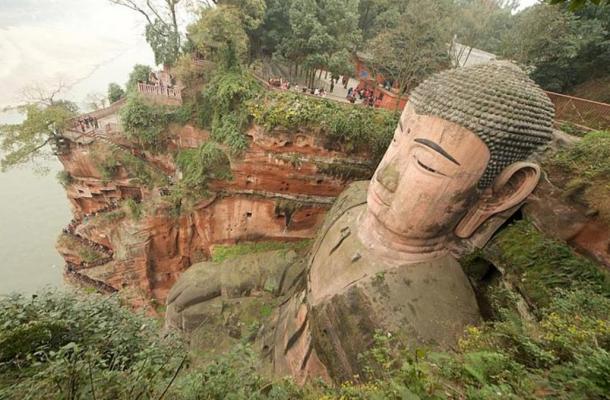
Not far from the city of Chengdu in Sichuan Province, China, sits the Leshan Giant Buddha statue. Carved into the side of Mt. Lingyun between 713-803 AD, the colossal statue is considered to be the largest stone Buddha in the world, and by far the tallest pre-modern statue. The site attracts millions of people every year, including Buddhist pilgrims, making it something of a sacred destination and an ancient wonder of the world.
The Leshan Giant Buddha statue (also known as Dafo) sits at the junction of three rivers: the Min River, Qingyi River, and Dadu River. It faces the sacred Mount Emei with the rivers flowing below its feet and depicts a stout, smiling monk, calmly sitting, resting his hands upon his knees with heavy-lidded eyes gazing across the river which he is said to have calmed. The statue is believed to be Maitreya, a Buddha symbolizing brightness and happiness. Worshipping Maitreya was especially popular between the 4th to 7th Centuries.
The appeal of the Buddha lies not only in its size but in its architectural craftsmanship. The entire statue is made of stone, except for the ears which were crafted out of wood, then affixed, and covered with clay. The Buddha’s hair is arranged in special spiraled curls with 1,021 twists that have been skillfully embedded in the head. Several drainage passages hidden inside the Buddha's hair, collar, chest, and back of the ears, have prevented the statue from serious erosion and weathering over the millennia.
7. The Sentinel Sarcophagi of the Warriors of the Clouds
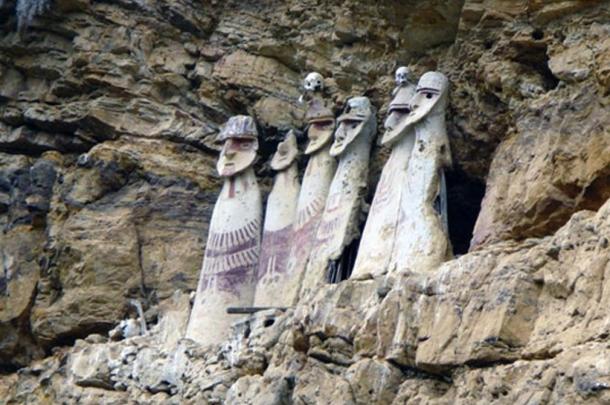
In 1928, a powerful earthquake shook the hills surrounding the Utcubamba valley in Peru, revealing a 7 foot (2.1 meter) tall clay statue, which came crashing down from the cliffside. Researchers were stunned to find that the figure was in fact a sarcophagus, and inside it were the remains of an individual carefully wrapped in cloth. Following this discovery, more of these sarcophagi were uncovered and subsequently named the ‘purunmachu’ – where the famed Warriors of the Clouds placed their dead.
The Warriors of the Clouds, also known as the Chachapoya people, were a culture of Andean people living in the cloud forests of the Amazonas region of present day Peru. Archaeological evidence suggests that people began settling the region at least as early as 200 AD, but the Incas conquered their civilization shortly before the arrival of the Spanish in the 16th century. Once their culture had disappeared the sarcophagi were no longer sacred and so most were desecrated and destroyed by looters in search of any riches that might lie inside.
The purunmachu sarcophagi statues were carefully prepared using clay which was built around the wrapped up body of the deceased. The structure was then covered in a mixture of mud and straw and painted white or cream before adding on details such as necklaces, feathered tunics, and faces, painted on in shades of yellow and red ochre. The sarcophagi were placed on a low circular wall on the ledge of a high cliff face and, lined up, the purunmachu were like a row of sentinels guarding the dead.
8. The ancient Lycians and their spectacular rock-cut tombs
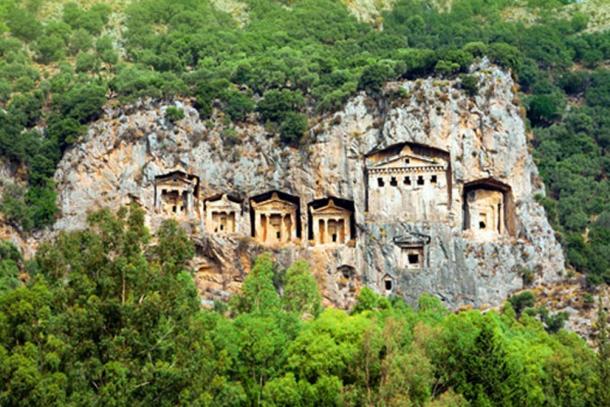
Lycia was situated in the modern provinces of Antalya and Muğla on the southern coast of Turkey, and the Burdur province, which is further inland. The Lycians were incorporated into the Achaemenid Empire by the 6th Century. However, one of the most interesting features left by the Lycians is their funerary culture, as seen in the incredible tombs that they built.
There are several types of Lycian tombs, the most common of which is the rock-cut tomb. The earliest examples of these are said to have been carved in the 5th century BC, and can be found in places such as Myra and Amasia. These tombs were carved directly into the rock face, usually into a cliff. It is said that the Lycians believed that a mythical winged creature would carry them off into the afterlife, which is the reason for the position of their tombs.
The tombs are often carved like the façade of Lycian houses, and usually have one or two levels, but sometimes even three. In addition, the tombs usually held more than one body, most likely of people who were related to each other. Thus, it seems that familial ties and kinship were maintained even after death.
9. The Unique Hanging Coffins of Sagada, Philippines
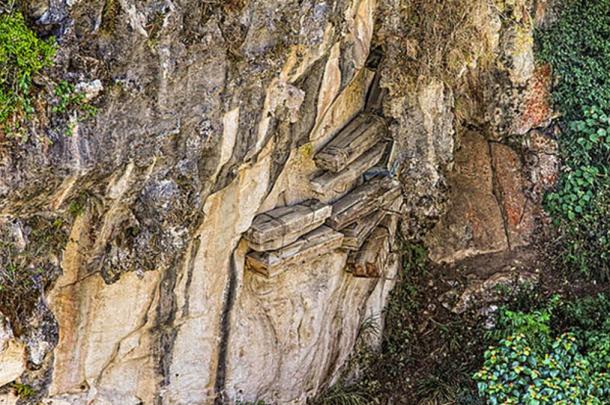
The Igorots are an indigenous tribe living in Sagada, Luzon Island, Philippines. The Igorots practice unique funerary customs, in which the dead placed into coffins attached to the side of cliffs. It is claimed that this practice is over 2000 years old, although nobody seems to know whether there are any coffins that are actually that old.
The coffins are carved by the elderly before they die. If an elderly person is too weak or ill to do so, his/her son, or a relative would do it for him/her. When the person dies, he/she is placed in the coffin in a fetal position. This is due to the belief that a person should exit the world in the same position that he/she entered it. After being wrapped up in blankets and tied with rattan leaves, the corpse is carried to a cliff in a procession. During this procession, mourners attempt to grab and carry the corpse to receive some of their blood and skills. After reaching the site for the burial, the corpse would be placed in the coffin and tied or nailed to the side of the cliff.
It is commonly thought that by placing the coffin on the side of a cliff, the deceased would be brought closer to heaven/their ancestral spirits. However, it has also been suggested that there were more practical reasons for the practice. For instance, the Igorots knew that corpses would decompose or quickly be eaten by animals when buried in the ground. Moreover, during the days when headhunting was a common practice, corpses buried in the ground would have been easy targets.
10. Pantalica: The Spectacular Honeycomb Tombs of Sicily
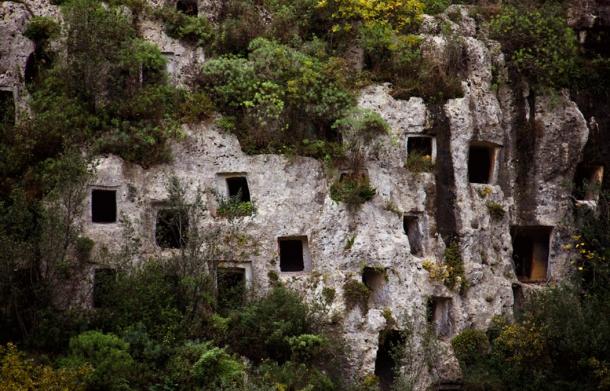
Hidden away in the Hyblaean Mountains of Sicily lies a prehistoric cemetery called the Rocky Necropolis of Pantalica - the largest stone necropolis on in Europe. Used during the late Bronze Age between the 13th and 7th century BC, it is a collection of cemeteries filled with thousands of tombs cut into the walls of a canyon resembling a beehive. Inhabited by various populations over the centuries, it was the center kingdom of the Sicels, one of the original Sicilian peoples.
About 5,000 of tombs or burial chambers are visible at the site, most of which have been carved into limestone. The tombs are relatively small in size and are either square, rectangular or elliptical in shape. Inside, they look like artificial caves with some having more than one room.
Pantalica was also inhabited during the 8th and 9th centuries AD, and served as a major point of defense against the Arab invasion of Sicily during the Christian and Byzantine period. The Pantalica also became a place of refuge for the Arabs, who named the place “Buntarigah” meaning caves. The Saracens (Muslims) found this inaccessible canyon to be perfect hiding spot for them and established a community here during the middle ages. Even today, the ancient houses built into the rocks during the Byzantine times are still visible along with the small rock chapels called Grottas.
By: Ancient Origins
Over the centuries, ancient people all over the world have built incredible structures on the sides of cliff faces. Some had a desire to be closer to the heavens and were searching for a sacred location, others sought a defensive outlook and protection from enemies, and still more found these locations to be ideal sites for the eternal resting of their deceased. The impressive structures used to achieve these goals include precariously hanging monasteries, giant statues, cliff-side tombs, and even entire villages that have been carved into cliffs.
1. The Precariously Hanging Monastery of Mount Heng

Hengshan, or Mount Heng, which is located in Shanxi province, is one of China’s Five Great Mountains. Pinned to the side of its cliff face is the Xuan Kong Si, also known as the Hanging Monastery. The monastery is dedicated to three religious systems – Buddhism, Taoism, and Confucianism, all of which co-exist harmoniously in the building and served to enable almost all travelers to rest there.
The Hanging Monastery was built in 491 AD, during the late Northern Wei Dynasty. It is commonly believed that the building of the monastery was initiated by a single individual, a monk by the name of Liao Ran, who later received help from Taoist builders. The site was perfect for those engaged in meditation, as noises from the ground did not reach such lofty heights. In addition, its height ensured that the monastery was safe from floods. The Hanging Monastery is also protected from rain, snow and sun as it is sheltered by the mountain’s peak. This is one of the reasons for the monastery’s continual existence over the centuries.
In order to provide support for the monastery, holes were first drilled into the side of the cliff. Wooden pillars were then half inserted into the rock as the foundation. The monastery was then built on top of these pillars, with additional support from the rock at the back of the building. It was subsequently enlarged over the centuries, and was also restored in 1900 during the Qing Dynasty.
2. The Thousand-Year History of the Spectacular Cliff Face Monastery of Sumela

The Sumela Monastery is one of the oldest and most historic monasteries in the Christian world. There are no exact records about when it was built or by who, but it is estimated that its history dates back some one thousand years and that the locals who constructed it did so to escape enemy attacks. This incredible feat of architecture is located high up on the steep cliffs above the surrounding forest in Trabzon, Turkey. Over the centuries, Sumela thrived and became an important location not only for monks, but for pilgrims. It changed hands many times over the course of its existence, until it was finally abandoned in 1923.
The structure appears almost glued to the mountainside and has an entrance that is reached by climbing a long and narrow stairway where there is a large aqueduct at the top with many arches, which has mostly been restored. The main buildings of the Monastery complex are its Rock Church (which is covered both inside and out with biblical frescoes), chapels, kitchens, student rooms, a guesthouse, library and a fountain used to collect spring water from the mountain, which was revered by the Greeks.
One popular legend says that two monks from Athens, St Barnabas and his nephew St. Sophronios, saw an image of the virgin in a cave (now the Rock Church) and decided to build the monastery on that spot in 386 AD. However, many historians maintain that the monastery was in existence long before this.
3. Paro Taktsang: The Breathtaking Himalayan Cloud Monastery

Paro Taktsang is located in the Himalayan mountains in Bhutan. It is one of the most revered places of pilgrimage, with a founding shrouded in strange tales and legend. Built in the late 17th century, it withstood the test of time until several years ago when it was nearly destroyed by fire. Today, it is considered to be one of the holiest sites in Bhutan as well as a cultural icon that is open only once a year in a special ceremony. The monastery also has an ancient history of occupation by monks, and monks who arrive here often stay for at least for three years, seldom leaving it.
The name “Taktsang" literally means Tiger's Lair and was derived when the people in the locality came across a tigress residing in one of the caves. The building of Paro Taktsang Monastery began in 1692, by Gyalse Tenzin Rabgye, Bhutan’s leader at the time. He is believed to have been the reincarnation of Rinpoche (a Brahmin royal who spread Tantric Buddhism throughout Bhutan and Tibet in the 700s) and founded the monastery by planting its first stone during a visit to the holy caves. Legend says that when the temple was built, it was anchored to the cliff by the hairs of female celestial beings known as khandroma.
The Paro Taktsang monastery has four main temples and residential shelters. Each building has a balcony, which provides views of the Paro valley below. The buildings are interconnected through rock stairways and steps along with several wooden bridges. There are eight caves, four of which are fairly easy to access. The entrance to the main cave is through a narrow passage. It holds twelve images of Bodhisattvas with butter lamps burning in front of these idols. Paintings can also be found on the walls of the monastery along with a sacred scripture which is kept in an adjoining small cell.
4. The Cliff Dwellings of Mesa Verde

Mesa Verde is a green sanctuary for the soul. Located in southwestern Colorado near the Four Corners region, this massive geological uplift was once home to many Ancestral Puebloans. Mesa Verde is Spanish for “green table,” and the area covered with juniper and piñon trees indeed provided refuge from the harsher and drier landscape of the high desert below.
Some of North America’s most spectacular cliff dwellings are found here, including Cliff Palace and Spruce Tree House. Occupied between 600 and 1300 AD, the mesa is cut by numerous canyons running generally north and south. These canyons are pocketed with giant rock alcoves under which the ancient people built large villages of sandstone. Cliff Palace was inhabited between about 1190 and 1300. It contains some 220 rooms and 23 circular kivas (subterranean, ceremonial prayer-chambers)—the largest cliff dwelling in the American Southwest. This pueblo, a sort of ancient stone apartment complex, also included a round tower and a four-story square tower from which the sacred “sun watchers” made their celestial observations.
5. Kizil Caves, earliest Buddhist caves in China, hide rare images from the time of the Silk Route

The Kizil Cave complex is believed to be the earliest major Buddhist cave complex in China, and is located in Baicheng County, Xinjiang. The development of this cave complex is said to have occurred between the 3rd and 8th centuries AD. There are 236 known cave temples carved into the cliff from east to west, spanning a length of 2 kilometers (1.2 miles). Of these, around 135 are still relatively intact.
Like other Buddhist rock-cut cave complexes, the caves at Kizil may be divided into two major categories: monastic cells which were simple and unadorned, and halls of worship which were often sumptuously decorated with murals and sculptures. These murals include sacred themes such as karma, as well as secular images of daily life such as farming, hunting, and playing music. Most of the murals are lacking in Chinese influence. As a matter of fact, only two of the caves at Kizil display Tang Chinese elements. By contrast, there is a greater presence of Graeco-Indian (Gandharan) and Sassanian (Iranian) elements. The occurrence of these Western artistic styles may not be as surprising as it may seem, considering that Western travellers along the Silk Route would have passed through Xinjiang on their journey to China.
6. The Leshan Giant Buddha: Largest Stone Buddha in the World

Not far from the city of Chengdu in Sichuan Province, China, sits the Leshan Giant Buddha statue. Carved into the side of Mt. Lingyun between 713-803 AD, the colossal statue is considered to be the largest stone Buddha in the world, and by far the tallest pre-modern statue. The site attracts millions of people every year, including Buddhist pilgrims, making it something of a sacred destination and an ancient wonder of the world.
The Leshan Giant Buddha statue (also known as Dafo) sits at the junction of three rivers: the Min River, Qingyi River, and Dadu River. It faces the sacred Mount Emei with the rivers flowing below its feet and depicts a stout, smiling monk, calmly sitting, resting his hands upon his knees with heavy-lidded eyes gazing across the river which he is said to have calmed. The statue is believed to be Maitreya, a Buddha symbolizing brightness and happiness. Worshipping Maitreya was especially popular between the 4th to 7th Centuries.
The appeal of the Buddha lies not only in its size but in its architectural craftsmanship. The entire statue is made of stone, except for the ears which were crafted out of wood, then affixed, and covered with clay. The Buddha’s hair is arranged in special spiraled curls with 1,021 twists that have been skillfully embedded in the head. Several drainage passages hidden inside the Buddha's hair, collar, chest, and back of the ears, have prevented the statue from serious erosion and weathering over the millennia.
7. The Sentinel Sarcophagi of the Warriors of the Clouds

In 1928, a powerful earthquake shook the hills surrounding the Utcubamba valley in Peru, revealing a 7 foot (2.1 meter) tall clay statue, which came crashing down from the cliffside. Researchers were stunned to find that the figure was in fact a sarcophagus, and inside it were the remains of an individual carefully wrapped in cloth. Following this discovery, more of these sarcophagi were uncovered and subsequently named the ‘purunmachu’ – where the famed Warriors of the Clouds placed their dead.
The Warriors of the Clouds, also known as the Chachapoya people, were a culture of Andean people living in the cloud forests of the Amazonas region of present day Peru. Archaeological evidence suggests that people began settling the region at least as early as 200 AD, but the Incas conquered their civilization shortly before the arrival of the Spanish in the 16th century. Once their culture had disappeared the sarcophagi were no longer sacred and so most were desecrated and destroyed by looters in search of any riches that might lie inside.
The purunmachu sarcophagi statues were carefully prepared using clay which was built around the wrapped up body of the deceased. The structure was then covered in a mixture of mud and straw and painted white or cream before adding on details such as necklaces, feathered tunics, and faces, painted on in shades of yellow and red ochre. The sarcophagi were placed on a low circular wall on the ledge of a high cliff face and, lined up, the purunmachu were like a row of sentinels guarding the dead.
8. The ancient Lycians and their spectacular rock-cut tombs

Lycia was situated in the modern provinces of Antalya and Muğla on the southern coast of Turkey, and the Burdur province, which is further inland. The Lycians were incorporated into the Achaemenid Empire by the 6th Century. However, one of the most interesting features left by the Lycians is their funerary culture, as seen in the incredible tombs that they built.
There are several types of Lycian tombs, the most common of which is the rock-cut tomb. The earliest examples of these are said to have been carved in the 5th century BC, and can be found in places such as Myra and Amasia. These tombs were carved directly into the rock face, usually into a cliff. It is said that the Lycians believed that a mythical winged creature would carry them off into the afterlife, which is the reason for the position of their tombs.
The tombs are often carved like the façade of Lycian houses, and usually have one or two levels, but sometimes even three. In addition, the tombs usually held more than one body, most likely of people who were related to each other. Thus, it seems that familial ties and kinship were maintained even after death.
9. The Unique Hanging Coffins of Sagada, Philippines

The Igorots are an indigenous tribe living in Sagada, Luzon Island, Philippines. The Igorots practice unique funerary customs, in which the dead placed into coffins attached to the side of cliffs. It is claimed that this practice is over 2000 years old, although nobody seems to know whether there are any coffins that are actually that old.
The coffins are carved by the elderly before they die. If an elderly person is too weak or ill to do so, his/her son, or a relative would do it for him/her. When the person dies, he/she is placed in the coffin in a fetal position. This is due to the belief that a person should exit the world in the same position that he/she entered it. After being wrapped up in blankets and tied with rattan leaves, the corpse is carried to a cliff in a procession. During this procession, mourners attempt to grab and carry the corpse to receive some of their blood and skills. After reaching the site for the burial, the corpse would be placed in the coffin and tied or nailed to the side of the cliff.
It is commonly thought that by placing the coffin on the side of a cliff, the deceased would be brought closer to heaven/their ancestral spirits. However, it has also been suggested that there were more practical reasons for the practice. For instance, the Igorots knew that corpses would decompose or quickly be eaten by animals when buried in the ground. Moreover, during the days when headhunting was a common practice, corpses buried in the ground would have been easy targets.
10. Pantalica: The Spectacular Honeycomb Tombs of Sicily

Hidden away in the Hyblaean Mountains of Sicily lies a prehistoric cemetery called the Rocky Necropolis of Pantalica - the largest stone necropolis on in Europe. Used during the late Bronze Age between the 13th and 7th century BC, it is a collection of cemeteries filled with thousands of tombs cut into the walls of a canyon resembling a beehive. Inhabited by various populations over the centuries, it was the center kingdom of the Sicels, one of the original Sicilian peoples.
About 5,000 of tombs or burial chambers are visible at the site, most of which have been carved into limestone. The tombs are relatively small in size and are either square, rectangular or elliptical in shape. Inside, they look like artificial caves with some having more than one room.
Pantalica was also inhabited during the 8th and 9th centuries AD, and served as a major point of defense against the Arab invasion of Sicily during the Christian and Byzantine period. The Pantalica also became a place of refuge for the Arabs, who named the place “Buntarigah” meaning caves. The Saracens (Muslims) found this inaccessible canyon to be perfect hiding spot for them and established a community here during the middle ages. Even today, the ancient houses built into the rocks during the Byzantine times are still visible along with the small rock chapels called Grottas.
By: Ancient Origins